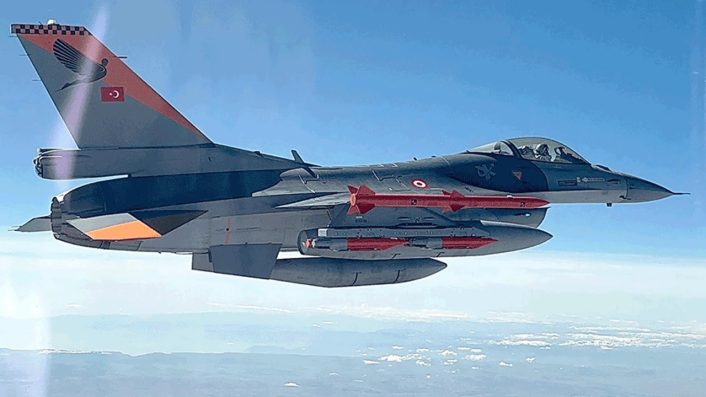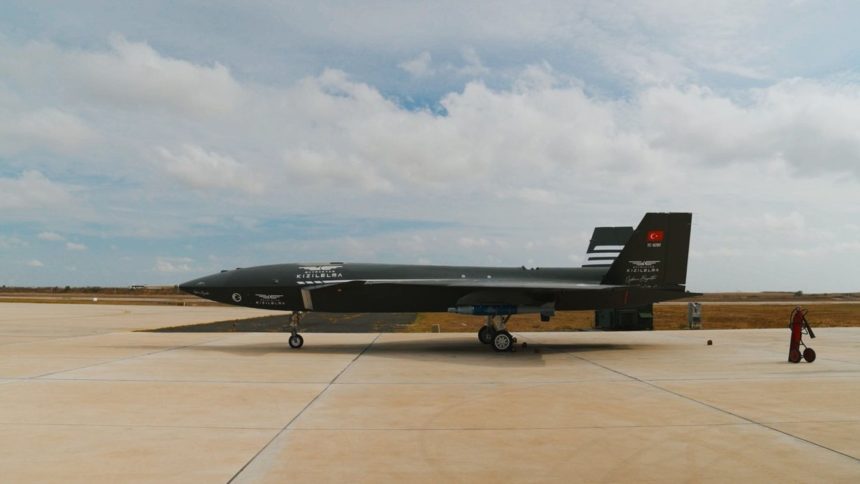The Kizilelma is slated to fly alongside the KAAN as its primary Collaborative Combat Aircraft, along with the ANKA-III.
Turkey’s Kizilelma UCAV, developed by drone and aerospace major Baykar, attained major milestones from late September to the early days of October with captive carry trials of homegrown air-to-ground munitions. On Sep. 27, 2025, Baykar announced the Kizilelma carried the TOLUN glide bomb, followed by the TEBER-82 guided bomb on Oct. 3, releasing footage on both occasions.
The Kizilelma is shown carrying two TOLUNs, one unit each on a SADAK-4T quad-rack under each of the wings, and is flying at low altitudes while performing a series of maneuvers like banking, yawing left and right, before coming back into land. This was likely done to evaluate the fitments and clasps on the rack holding the bomb, aerodynamic drag and handling. The landing gear is shown extended throughout the video.
In the test with the TEBER-82, Kizilelma is carrying only one unit on the left wing and flies with the gears retracted. Both the test flights are recorded in the air by electro-optical footage from an Akinci UCAV. The munitions are inert rounds, as denoted by the blue paint.
Teber güdüm kiti takılı Mk.82 bombasıyla havalanmış. Tek kanada yüklenmiş, asimetrik yükte uçuş karakteristiğini görmeye çalışıyorlar sanırım. Bu konfigürasyonda kanat uçlarında LAU-129 füze lançeri de kullanılabilir. Frenlemede kanard kullanılmış. https://t.co/MhMbphZHhB pic.twitter.com/Ujy9KBi7qv
— 𝚅𝚎𝚌𝚒𝚑𝚒 (@captzulu737) October 3, 2025
Kizilelma’s testing
With no weapon release taking place, the tests appear to be standard captive carry trials of the TOLUN or the TEBER-82, assessing the integration of the UCAV’s mission and fire control system with the bombs. Such test flights also include trialing the electrical and electronic connections and the impact the payloads have on the airframe and the flight profile.
This testing shows the possibility that Kizilelma could be used for surveillance-strike roles on land targets. The UCAV has been consistently touted as the future wingman CCA for the KAAN fighter, whose second prototype is now under production.
It has been previously speculated the Kizilelma would receive Aselasan’s ARAT 100 IRST (Infrared Search and Track) on top of the nose and the TOYGUN 100 EOTS (Electro-Optical Tracking System) under the chin. That upgrade was shown in public during July 2025’s IDEF25 exhibition, where the new Kizilelma prototype was seen with these systems installed.
Çok şükür, görmek istediğimiz testlere sıra gelmiş. Akıncı yavaş ve manevra yeteneği düşük ama KE daha hızlı ve daha yüksekten uçuyor. Potansiyeli çok fazla.https://t.co/4TVLeZN6Fv pic.twitter.com/TlUZLIAzMH
— 𝚅𝚎𝚌𝚒𝚑𝚒 (@captzulu737) September 26, 2025
However, the Kizilelma flying with the Tolun and the Teber-82 does not have them installed, and we are likely to see those in future trials. The Kizilelma airframe in the tests is also the newer third prototype that The Aviationist reported on Jul. 24, 2024 and which flew for the first time on Sep. 25 of the same year.
TOLUN and TEBER-82
The existence of the TOLUN bomb has been reported since late 2022, when Turkish defense news outlets reported integration activities of the Tolun and the Akinci. Aselsan developed both the weapon and the SADAK-4T Smart Pneumatic Quad Rack to carry four pieces of the munition.
The TOLUN is a GPS/INS guided munition for use against soft and hardened targets. Its warhead is designed by Tübitak SAGE, with Aselsan developing the rest of the system.
On Aug. 9, 2024, the TOLUN bomb was released by the Akinci UCAV on a floating target at sea. The weapon achieved a major milestone on Jan. 13, 2025, when an ANKA III UCAV dropped it from its internal bays for the first time.

Aselsan is also developing an IIR (Imaging Infrared) seeker variant to hit moving targets and an unnamed “ground-launched version with Delta-V’s hybrid fuel rocket motor”. The former will use a pod to keep the pilot “in the loop.”
The ground launched variant suggests launch by an MLRS (Multiple Rocket Launch System) like the TRG-230. This is similar to the U.S.-made GLSDB (Ground-Launched Small Diameter Bomb), that fires the modified GBU-39 SDB from the HIMARS (High Mobility Artillery Rocket System).
According to TurDef, TOLUN “achieved important milestones such as four simultaneous hits and hitting its target under intense GPS jamming” after being dropped by an F-16 in early 2024. An F-16 can carry eight TOLUNs on two SADAK racks. An air-dropped TOLUN guided by GNSS and INS has a range of more than 110 km.
The TEBER kit, similar to the JDAMs, transforms Mk-81 and Mk-82 bombs into guided munitions with dual laser and GPS-guidance. Prior to the release of the TOLUN from the internal bays, the ANKA III completed its first armed flights with a TEBER-82 on Sep. 1, 2024, carrying the guided munition on its left wing.

Future
It is unclear if Baykar has planned a fourth Kizilelma prototype, or if the third is in the same final configuration that would go into production. Given the complex nature of networking, sensor fusion and autonomous flight technology, hardware, electronics and software associated with CCAs, it would require dozens of rigorous test flights and modifications before the Kizilelma is even tested alongside a manned fighter, let alone going into serial production.
Das türkische unbemannte Kampfflugzeug #KIZILELMA mit AESA Radar integrierten IRST (Infrarot-Such- und Tracking-System) und
EOTS (Electro-Optical Targeting System) .
Diese Systeme, die von #ASELSAN entwickelt wurden, sind für die Luft-Luft- und Luft-Boden-Aufklärung und… pic.twitter.com/yx4Jz18yBi
— Verteidigungsindustrie der Türkei (M.E.A) (@denizaltici) September 30, 2025
Turkey’s development of a credible UCAV and CCA program is also a force multiplier and hedge against being denied advanced jets like the F-35A, assuming its rival Greece receives it first. Turkey has also developed the long-range SİPER – that local commentators call Ankara’s analogue to the Russian S-400; medium-range HİSAR-O, short-range HİSAR-A and HİSAR-A+; and low-altitude, short-range Sungur systems; Bozdoğan (short-range), Gökdoğan and Gökhan BVRs; and the Tayfun short and medium-range ballistic missile family.
🇹🇷
Turquie: Le drone Kızılelma de Baykar sera équipé de capteurs avancés similaires à ceux des avions de 5e génération comme le F-35. Il disposera notamment d’un radar AESA (MURAD-200A), d’un EOTS (T-100), d’un IRST (KARAT-100), ainsi que d’un système DAS et d’un MWS pour la… pic.twitter.com/C5vWGf77Ng
— Restitutor Orientis 🇨🇭 (@restitutorII) February 22, 2025
These homegrown systems afford a lot of flexibility in any conflict in the Mediterranean. As for the Kizilelma, a drop test of the air-to-ground munitions, captive carrying and live-firing of any of the above AAMs, and flying with the KAAN, will show the direction in which it is heading. The only other CCA which has rapidly progressed this far and is now poised to undergo a live-fire of an AAM is Boeing Defence Australia’s MQ-28A Ghost Bat.









